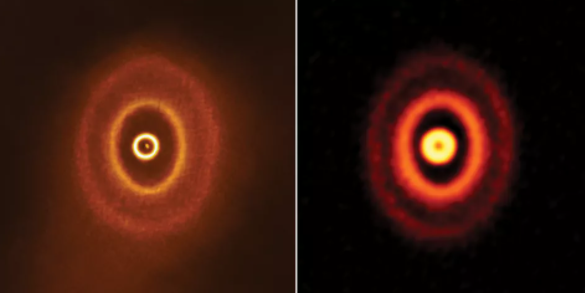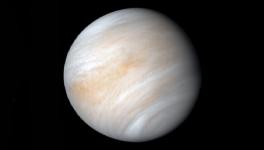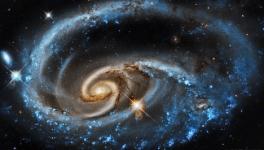Astronomers May Have Found Rare Planet that Orbits Three Suns Simultaneously

Image Courtesy: ALMA (ESO/NAOJ/NRAO), S. Kraus & J. Bi; NRAO/AUI/NSF, S. Dagnello
What could have been a fascinating story for a science fiction book, now appears to be a reality. Scientists have now even more evidence about the existence of a bizarre star system in the constellation (An area on the celestial sphere where groups of stars visibly form a pattern) of Orion, where a single planet orbits three suns (stars) simultaneously.
The star system is named GW Orionis and is located at a distance of about 1300 light-years from Earth. The star system has three dusty orange rings that nest inside one another. Astronomers view the star system as a huge bull’s eye in the sky. At the centre are three stars, with two having tight binary orbits with each other and the third spirals widely around the other two.
This kind of triple star system is rare in the cosmos. The GW Ori surprises scientists even more. Back in 2020, in a paper published in the Astrophysical Journal Letters, researchers closely observed the star system with the help of the ALMA (Atacama Large Millimeter/submillimeter Array) telescope in Chile. They observed an unusual phenomenon— the three dust rings were found to be misaligned with one another and the innermost ring was swaying wildly in the orbit.
The team then came out with the proposal that a young planet could be in the making, which best explains the phenomenon. They did not know whether such a young planet was really emerging in the GW Ori, however, they believed that if their predictions are true then it would become the first triple-star planet in the universe.
Now, a recent paper published in the journal Monthly Notices of the Royal Astronomical Society, provides more evidence that such a young planet actually exists. The researchers of the study conducted 3-dimensional simulations in an attempt to model how the mysterious gaps between the rings of the star system came into existence.
The team had two hypotheses, with one saying that there exists a planet that has given rise to the break in the dust rings. The simulation models suggest that there exists an enormous planet of a size equivalent to that of Jupiter.
However, this study is based on simulation modelling and there was no actual observation data. In future, if observations of the system support the theoretical propositions made out in the study, then GW Ori will become the first evidence of a triple planet system or a circumtriple planet.
The researchers, however, said, “Sadly, a hypothetical observer of this may be but the planet wouldn't actually be able to see all three suns rise and fall in the sky; the two stars at the centre of the system move in such a tight binary orbit that they would appear as one great star, with the third swooping around them.”
Confirmatory observations of this theoretical framework would bear broader implications. It will provide proof that planets can form under a diverse array of conditions than scientists thought previously. Again, if the theoretical propositions could not be verified in future then that could open up new hypotheses, theories or understandings of the universe, especially the formation of planets.
Get the latest reports & analysis with people's perspective on Protests, movements & deep analytical videos, discussions of the current affairs in your Telegram app. Subscribe to NewsClick's Telegram channel & get Real-Time updates on stories, as they get published on our website.
















